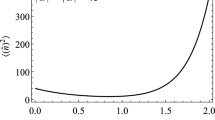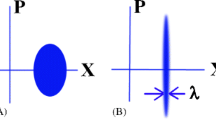Abstract
We study the nonlinear dynamics of the interaction of two-level atoms and a selected mode of a high-Q cavity with frequency modulation analytically and numerically. In the absence of modulation, the corresponding semiclassical Heisenberg equations for the expectation values of the collective atomic observables and the field-mode amplitudes allow, in the rotating wave approximation and in the strong-coupling limit, an exact solution with arbitrary detuning. Using this solution, we detect the coherent effect of trapping of the population of atomic levels and of trapping of the number of photons in the cavity. The explanation for this effect lies in the destructive interference of the atomic dipoles and the field mode. The integrable version of the system of equations exhibits a separatrix near which a stochastic layer is formed when modulation is introduced. The width of the layer is found to gradually increase with degree of modulation, and finally it fills the entire energy-permissible volume of the phase space. We show that the rotating wave approximation does not hinder the formation of Hamiltonian chaos in cavity semiclassical electrodynamics. The calculation of the maximum Lyapunov indices of nonlinear (in this approximation) equations of motion as functions of the modulation frequency δ and the frequency of natural Rabi oscillations of the atom-field system, Ω, suggests that Hamiltonian chaos appears first in the area of the fundamental parametric resonance, δ/2Ω≃1. Parametric instability increases with increasing modulation and decreasing detuning from the atom-field resonance, generating at exact resonance new areas of chaos corresponding to multiple parametric resonances. The results of numerical experiments and estimates of the characteristic parameters show that Rydberg atoms placed in a high-Q microwave cavity are possible objects for observing parametric instability and dynamical chaos.
Similar content being viewed by others
References
J. M. Raimonds and S. Haroche, in Confined Electrons and Photons, E. Burstein and C. Weisbuch (Eds.), Plenum Press, New York (1995), p. 383.
Y. Kaluzny, P. Goy, M. Gross, J. M. Raimonds, and S. Haroche, Phys. Rev. Lett. 51, 1175 (1983); G. Rempe, H. Walter, and N. Klein, Phys. Rev. Lett. 58, 3523 (1987).
E. T. Jaynes and F. W. Cummings, Proc. IEEE 51, 89 (1963).
P. I. Belobrov, G. M. Zaslavskii, and G. Kh. Tartakovskii, Zh. Éksp. Teor. Fiz. 71, 1799 (1976) [Sov. Phys. JETP 44, 945 (1976)].
R. F. Fox and J. C. Eidson, Phys. Rev. A 34, 482 (1986).
L. E. Kon’kov and S. V. Prants, J. Math. Phys. 37, 1204 (1986).
S. V. Prants and L. E. Kon’kov, Phys. Lett. A 225, 33 (1997).
L. E. Kon’kov and S. V. Prants, JETP Lett. 65, 833 (1997).
A. V. Andreev, V. I. Emel’yanov, and Yu. A. Il’inskii, Cooperative Phenomena in Optics: Superradiation, Bistability, and Phase Transitions [in Russian], Nauka, Moscow (1988).
I. L. Kirilyuk, L. E. Kon’kov, and S. V. Prants, submitted to Rep. Math. Phys.
G. T. Moore, J. Math. Phys. 11, 2679 (1970).
V. V. Dodonov, A. B. Klimov, and V. I. Man’ko, P. N. Lebedev Physics Institute Preprint No. 41, Moscow (1991).
B. S. Dewitt, Phys. Rep. 19, 295 (1975); V. V. Hizhnyakov, Quantum Opt. 4, 277 (1992).
K. Zaheer and M. S. Zubairy, Phys. Rev. A 39, 2000 (1989).
V. I. Oseledec, Trudy Mosk. Matem. Obshch. 19, 179 (1968) [English transl. in Trans. Moscow Math. Soc., Vol. 19, American Mathematical Society, Providence, R.I. (1969)].
Yu. B. Pesin, Dokl. Akad. Nauk SSSR 226, 774 (1976) [sic].
A. A. Brudno, Usp. Mat. Nauk 33, 207 (1978).
V. M. Alekseev and M. V. Yakobson, Phys. Rep. 75, 287 (1981).
D. V. Anosov and Ya. G. Sinai, Usp. Mat. Nauk 22, 107 (1967).
G. M. Zaslavskii and B. V. Chirikov, Usp. Fiz. Nauk 105, 3 (1971) [Sov. Phys. Usp. 14, 549 (1972)].
A. Heidmann, J. M. Raimond, S. Reynaud, and N. Zagury, Opt. Commun. 54, 189 (1985).
G. P. Berman, E. N. Bulgakov, and D. D. Holm, Phys. Rev. A 49, 4943 (1974).
Author information
Authors and Affiliations
Additional information
Zh. Éksp. Teor. Fiz. 115, 740–753 (February 1999)
Rights and permissions
About this article
Cite this article
Prants, S.V., Kon’kov, L.E. Parametric instability and Hamiltonian chaos in cavity semiclassical electrodynamics. J. Exp. Theor. Phys. 88, 406–414 (1999). https://doi.org/10.1134/1.558810
Received:
Issue Date:
DOI: https://doi.org/10.1134/1.558810




